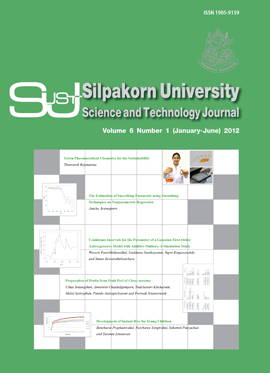Development of Instant Rice for Young Children
Main Article Content
Abstract
The objective of this research was to find a suitable method for producing an instant rice product fromThai Jasmine rice for young children aged 1-3 years old. Different methods of rice cooking, pre-treatmentprior to drying, and rehydration were studied. Volume expansion, rehydration ratio, rehydration time, colour,texture, and sensory characteristics of instant rice product were compared. The results showed that the instantrice product prepared by boiling followed by freezing for 24 h at –20 ºC, drying at 70 ºC, and rehydrationby boiling for 3 min showed no significant difference in hardness, adhesiveness, or cohesiveness from thefreshly cooked rice. The hardness, adhesiveness and cohesiveness were 349.75 ± 3.94 N, –23.09 ± 1.30N.s, and 0.49 ± 0.01, respectively. The sample also received the highest scores for stickiness, softness, andoverall acceptability for use as food for young children. Boiling followed by 24 h of freezing prior to dryingis recommended for producing instant rice for young children.
Downloads
Article Details
References
Carlson, R. A., Roberts, R. L., and Farkas, D. F. (1979). Process for preparing quick-cooking rice. U.S. Patent No. 4133,898.
Chiang, P. Y. and Yeh, A. I. (2002). Effect of soaking on wet-milling of rice. Journal of Cereal Science, 35: 85-94.
Kiathanapaiboon, S. (2008). Relation among chemical, physical, and descriptive sensory qualities and likeness of different varieties of rice cooked by different methods. Thesis, Kasetsart University (in Thai).
Kongseree, N., Wongpiyachon, S., Sawangjit, P., Youngsuk, L., and Hirannupakorn, W. (2002). Production of instant rice. Research during 1991-2001. Department of Rice Research and Development, Ministry of Agriculture and Cooperatives (in Thai).
Lu, T.-J., Jane, J.-L., and Keeling, P. L. (1997). Temperature effect on retrogradation rate and crystalline structure of amylose. Carbohydrate Polymers, 33: 19-26.
Luangmalawat, P., Prachayawarakorn, S., Nathakaranakule, A., and Soponronnarit, S. (2008). Effect of temperature on drying characteristics and quality of cooked rice. Journal of LWT ,41: 716-723.
Mohamed, A., Peterson, S. C., Grant, L. A., and Rayas-Duarte, P. (2006). Effect of jet-cooked wheat gluten/lecithin blends on maize and rice starch retrogradation. Journal of Cereal Science, 43: 293–300.
Ong, M. H. and Blanshard, J. M. V. (1995). Texture determinants in cooked, parboiled rice: I. Rice starch amylose and the fine structure of amylopectin. Journal of Cereal Science, 21: 251-260.
Prasert, W. and Suwannaporn, P. (2009). Optimization of instant jasmine rice process and its physicochemical properties. Journal of Food Engineering, 95: 54-61.
Rewthong, O., Soponronnarit, S., Taechapairoj, C., Tungtrakul, P., and Prachayawarakorn, S. (2011). Effects of cooking, drying and pretreatment methods on texture and starch digestibility of instant rice. Journal of Food Engineering, 103: 258-264.
Tester, R. F. and Morrison, W. R. (1990). Swelling and gelatinization of cereal starches. Effects of amylopectin, amylase and lipids.Cereal Chemistry, 67: 551-557.

